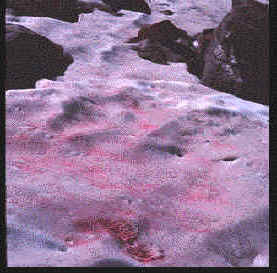|
|
|
Snow is really ice shaped into tiny crystals. Most of the time the snowflake is made up of many of these tiny ice crystals stuck together. Like raindrops, snowflakes begin as water vapour in a cloud. When a cloud is very cold this water vapour changes into ice crystals. If you could look at a snowflake under a microscope you would see that each crystal has a beautiful six-spoked shape which is usually symmetrical. A scientist, Wilson 'Snowflake' Bentley, took over 6,000 photographs of individual snow crystals between 1880 and his death in 1931. No two were alike. |
|
Why is snow white?
| Ice is transparent, yet snow looks white. This is because
the ice crystals in snow reflect daylight in all directions. Daylight is white so
the snow appears white.
However, red, green, blue and even black snow is occasionally seen in many parts of the world. The colours are due to the dust or fungi collected by the snow as it falls through the air. Red snow occurs in some areas of Europe - especially Italy - where the air is filled with dust particles from the red sands of the Sahara desert. Snowflakes that form around dust particles take on a reddish colour. |
Light reflecting off snow makes it look white. |
|
 |
 Red snow caused by fungi |
|
What uses does snow have?
 Igloo made of Snow blocks but still surprisingly warm!
Igloo made of Snow blocks but still surprisingly warm!
|
Snow has many
uses in nature. A thick layer of snow does not allow heat
to escape from the ground
beneath it.
It works like a blanket to save plants and animals from the damage
caused by freezing temperatures. Although it may be cold above the ground, snow is a
good insulator, and keeps the heat
underground in. It is because snow keeps heat in
that many Eskimos and Arctic
explorers
build igloos of snow blocks. Snow is often a very useful source of water supply, especially in hot, dry countries. Often, deep layers of snow on high mountains will not melt until late spring or early summer. Rivers like the Nile in Africa, and the Indus in India, would dry up in hot weather without supplies of melting snow. Another use of snow is all the fun you can have when the ground is covered in snow.
|

Snow on mountain caps provides water to lower land areas as it melts. |
Some fun snow facts.